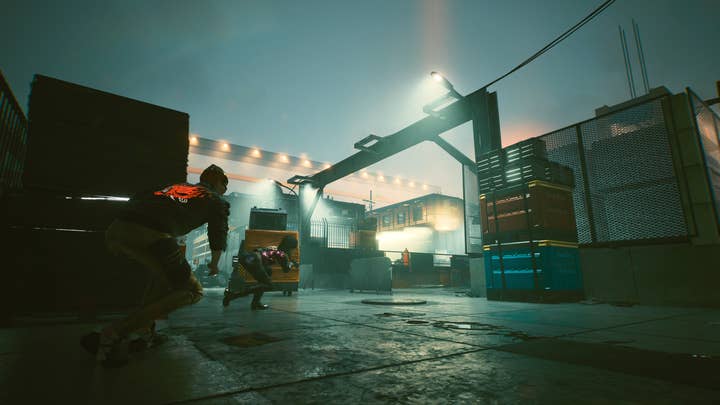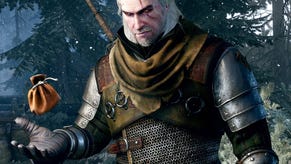How Cyberpunk 2077 shaped CD Projekt Red's approach to level design
Max Pears discusses the developer's work environment and core development principles ahead of Phantom Liberty DLC
Sign up for the GI Daily here to get the biggest news straight to your inbox
It's rare to be given an insight into the development of an AAA game like Cyberpunk 2077. But Max Pears, former senior level designer at developer CD Projekt Red, discussed the inner workings of the studio and its philosophies during his talk at Develop Brighton last month.
Pears' talk, entitled 'Johnny Silverhand's Porsche: Designing levels for Cyberpunk 2077,' was explicitly targeting level designers, but also touched upon CD Projekt Red's workplace environment, sharing his experience working with the level design team on Cyberpunk 2077 and its upcoming DLC, Phantom Liberty (due to release on September 26).
Level design was a "new thing" for CD Projekt Red when approaching Cyberpunk 2077, according to Pears, with the developer previously relying on environment artists and quest designers. Quest director Mateusz Tomaszkiewicz previously told GamesIndustry.biz that the team working on Cyberpunk 2077 was "at least twice the size" of The Witcher 3 and was composed of experts from various fields.
In addition to Pears, the design team that worked on the side mission featured in the talk included quest director Paweł Sasko, environment artist Timur Ozdoev, gameplay QA analyst Paweł Kucal, and writer and narrative designer Ola Motyka.
Pears, who joined CD Projekt Red as it was finishing off The Witcher 3's Blood and Wine DLC in 2017, shared that the developer was somewhat wary of working with a dedicated design team.
"It was best for us as level designers to block out the spaces and think about the routes that were available for different playstyles"
"Level design was kind of a new thing for them," he said. "Their pipeline throughout The Witcher development process was that environment artists would build all the space, and then quest designers would script it.
"But it's a new IP and they were more concerned with feeling that they didn't want us to take over how they were working or feel like they were losing control. So this was the first challenge we had to think about – how do we make sure that we don't feel that we're encroaching on them, and that they also understand how important level design is, especially on a game like Cyberpunk?"
The team did this by focusing on a pipeline that centred around how their roles and individual priorities would slot into place.
"We discovered that it was best for us as level designers to block out the spaces and think about the elements of the routes that were available for all these different playstyles," Pears explained.
"Environment artists would focus on designing Night City and building the base layer for us, then going in and making sure our world and our levels looked beautiful. Quest designers would work really closely with narrative design, and would be in charge of scripting dialogues as well as speaking with the animators to make sure they had enough space to implement any cutscenes and communication scenes."
The design team collaborated on various levels, including the side mission Chippin' In featured in Pears' talk, having to balance a substantial workload between them. These side quests and optional encounters can sometimes run longer than the main story missions, and be equally as demanding to build. The need to design both main and side missions alongside other encounters simultaneously added to the pressure the team faced.
Pears worked on two main missions, two side missions, 14 smaller side quests, 30 combat events, and designed two sub-districts. Sasko worked on one main mission, seven side missions, and district lore. Ozdoev was assigned two main missions and two side missions while building interiors and designing sub-districts. Kucal and Motyka were also working on multiple missions and side missions alongside mechanic and engine development, and producing promotional material.
And that was in addition to any admin and/or leadership tasks that most of them would have been expected to carry.

Pears said the challenge in designing as a team was balancing the workload between them, all the while working across Krakow and Warsaw in Poland.
"For many of you who may not have been to Poland, that's like the same distance between London and Newcastle," he clarified, which is about 455 km (283 miles). "The good news though [is] it was all something we were able to figure out. And then COVID came in and threw a little spanner in that."
CD Projekt Red had clear guidelines in place to keep the team on track and progress with development. Pears shared the studio's "core pillars" that everyone had to follow during development to make sure different levels made by different people ran seamlessly.
These three core principles focused on freedom in the story, world, and gameplay, to guide developers when building levels. This included observing how the player's choices impact the narrative, letting the player freely explore the open world, and catering levels to specific playstyles.
While there's no fixed class system in Cyberpunk 2077, there is a skill tree with over 200 passive abilities to suit particular playstyles like stealth or melee combat. But, as Pears explained, instead of catering to hundreds of different outcomes for each level, the team sought to focus on five main playstyles and facilitate them in different ways. This was achieved by providing decision points throughout the level for players to use and plan their next move or adapt different tactics.
"This was crucial for our level design moments," Pears said. "Once you completed a challenge – whether that be an enemy, puzzle, or trap – there was always a different route available for the player to see and then choose to move forward from."
To streamline this process, Pears and the team implemented a funnel design so that, regardless of what path players chose, they could reach the same objective. Pears said that by using this approach, players could "mix and match their paths but not miss key narrative beats."
"The mantra over at CD Projekt Red is that 'story and narrative is king'," he added. "So we needed to make sure that the player [didn't] miss any of that."

For example, the level featured in Pears' talk experienced a substantial change in objective during its design. It originally featured a major boss fight, but this was later scrapped in favour of spotlighting important narrative moments.
As the objective and design of the location changed, Pears decided it was "best to start over, re-design from scratch to meet the new design." He used this side mission to guide the talk's audience through the intricacies of blocking a level, from implementing pinch points for transitions, safe areas where players can stock up on ammo, and clear pathways for different playstyles using the funnel method.
However, Pears said the drastic change in objective for the featured level resulted in "a lot of time lost" and a "lot of time moving fast." And as the team were all working on other tasks alongside this level, they were under a lot of pressure to research, design, block, create, and test it out within a narrow timeframe.
This caused the team to often find themselves struggling to maintain a "unified vision" across the game's development. Rectifying this was a high priority for Pears, where he noted one level could be more vital to the narrative in some instances, making it difficult to translate and nail down "what exactly makes a quintessential Cyberpunk level" when some members of the team may be working on something else.
"Because of that, everyone interpreted the rules and mechanics in different ways," Pears said. "I think having a shared vision not only makes it a lot easier to break the rules, but to also make sure that the quality is raised."
"I think having a shared vision not only makes it a lot easier to break the rules, but to also make sure that the quality is raised"
This often meant that the team didn't have much time to set aside to play through each other's levels. Pears highlighted that it's essential for time to be put aside for team play as this can provide critical impact from each discipline. Without it, feedback can tend not to be constructive enough when done individually.
On that end, Pears said that though he and the team recognised everyone was dedicating time to their assigned tasks, in retrospect they should have found the time to listen to each other "for the sake of the mission" and their work.
It wasn't just Pears that felt that changes needed to be made internally. His sentiments echoed CD Projekt Red's VP of PR and communication Michał Platkow-Gilewski, who told GamesIndustry.biz that the developer needed to restructure the way its teams collaborated.
"We needed to rethink how we were working in bigger groups and make sure that everyone listens to each other," he said earlier this year. "[We] also [need to] make sure we empower teams to work on their fragments of the game but, when you combine everything together, it runs smoothly from all sides."
The hope was to avoid a repeat of its troubled history with crunch culture. Even though CD Projekt Red co-founder Marcin Iwiński's said that a "non-obligatory crunch policy" was in place during development in May 2019, reports in 2020 emerged that the policy was said to be mandatory.
In the run up to the game's release, which had already experienced three delays, CD Projekt CEO Adam Kiciński confirmed that employees had been required to crunch to prepare the game for launch.
As for the upcoming DLC Phantom Liberty, which Pears also worked on before leaving CD Projekt Red in late 2021, Platkow-Gilewski said the developer knew there was hard work ahead to make things right.
"We had to rebuild a lot of things inside of the company. We started with pipelines on the dev side [...] we made some decisions about how we work, how we are structured.
"At the same time as this, we wanted to work on Cyberpunk and make not just a great expansion, but also improve a lot of things in the base game. It was quite a journey, but right now I am just excited to see what people will say when they start playing."
Sign up for the GI Daily here to get the biggest news straight to your inbox
GamesIndustry.biz is a media partner of Develop:Brighton



